#arboreal reptiles baby
Text

Big Guy Iguana at the San Pedro Iguana Eco Sanctuary
It’s a neat, small piece of land lined by mangroves and lagoon and swamp, and if you go I recommend going around 9 or 10 because that’s when they get fed.
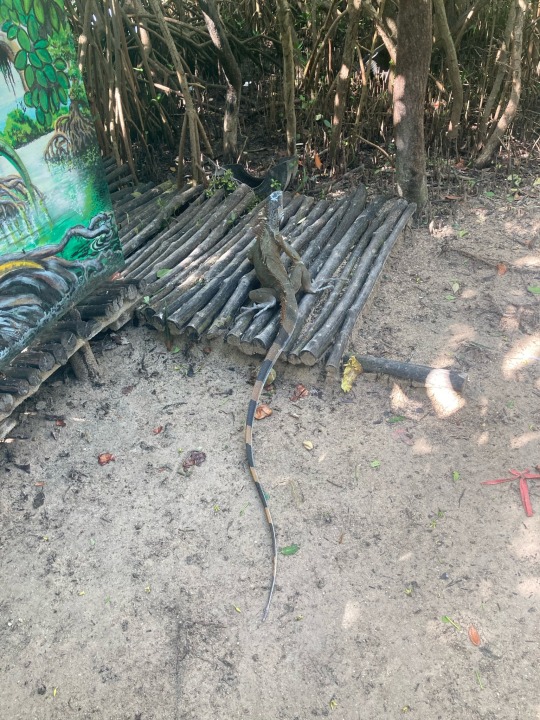
This lovely lady was provably the most social and when offered a banana elected to lick my sleeve instead (I assume in the hope it might be lettuce).
1 note
·
View note
Text
GOD
I don’t understand why people think it’s okay to get reptiles and abuse them.
I’m searching Facebook marketplace for a tank and see the SADDEST reptile tank with a leopard gecko in it. THE FUCKING TANK IS FOR AN ARBOREAL SPECIES. So it’s extremely small with NO hide, NO heat, and a sad little gecko “living” in it.
I messaged the person to see if they would sell the gecko to me. I literally can’t stop thinking about the poor baby.
21 notes
·
View notes
Text
The magic of mountains in Mesoamerica.
Active volcanoes covered in thick green coats of misty cloud forest and rainforest. A focal point, an epicenter, the meeting place between two oceans and two continents. The origin of the revered orchid, vanilla!
Here, an absurd amount of endemic species with very small limited distribution ranges in Central America and Mesoamerica. Out of about 700 species of reptiles living in Mesoamerica, over 200 live nowhere else. Out of about 550 species of amphibians living in Mesoamerica, over 350 live nowhere else.
And this extreme biodiversity is boosted by the presence of so many mountain ranges located within the tropics, so that “cooler” habitats (at high elevations) can exist closer to the heat of the equator. And orographic uplift (rain in the mountains) means that humid and wetter habitats (”sky islands”) can exist closer to dryland habitats (arid valleys). And also different habitats can occur so close next to each other along the slopes of a single mountain (”altitudinal zonation”). And this is in addition to how the region is the meeting place between ecosystems of South America and North America, and between the Caribbean Sea and the Pacific Ocean.
So that there can be about 30 species of hummingbirds that only live in Mexico and Central America.
Or there can be like 11 different species of venomous palm pit vipers all in the same genus living in just a couple of mountain ranges between merely San Jose and Ciudad de Guatemala.
Or how, within the borders of Guatemala alone there are at least 40 different species of salamanders, and most of them are so-called arboreal “climbing salamanders” which live in bromeliads and fern mats growing in the branches of trees.
Like how the mangrove hummingbird only lives in brackish swamps of the mangrove forests along the seashore of a stretch of coastline only within the borders of Costa Rica, and the hummingbird depends on the nectar from the flower of one species of tea mangrove (Pelliciera rhizophorae).
Consider the Motagua beaded lizard (Heloderma charlesbogerti), a species of venomous lizard in the same genus as and closely related to the beloved Gila monster. It’s an endemic species, living only in one valley, and there are less than 200 Motagua beaded lizards surviving in the wild. It’s “one of the rarest and most endangered lizards on the planet.” And for food, it relies on the eggs of the Motagua spiny-tailed iguana (Ctenosaura palearis), of which there are less than 2,500 surviving in the wild, making it another of the planet’s most endangered lizards. Two lizards, found nowhere else, entwined in a relationship, almost extinct. But it gets more incredible. For food, the Motagua spiny-tailed iguana itself relies on the fruit of several cactus species. (One of the dryland plants that the iguana relies on is Pereskia lychnidiflora, one of the only cactus-type plants that basically produces leaves.) Without the cactus fruit, the Motagua spiny-tailed iguana would disappear. Without the Motagua spiny-tailed iguana’s eggs, the venomous Motagua beaded lizard would disappear.
Think of frogs like Bromeliohyla bromeliacia. There are colorful poisonous tree frogs whose aquatic baby tadpoles swim around in the tiny pools of rain water that temporarily collect in flowers growing on tree branches and in forest canopies. A whole multiplicity of “small” worlds existing, some ephemerally and some more permanently. Whole unique ecosystems in the treetops.
Here, the Pacific Ocean and the Atlantic Ocean nearly kiss. They are separated by less than 70 kilometers of land! You could stand on the peak of a Central American volcano, drinking native cocoa flavored with vanilla, and nearly toss a stone between these two marine universes.
Amphibians, reptiles, and hummingbirds in Mesoamerica were just like: “Let’s find a mist-shrouded cloud forest near the slopes of an active volcano in a single mountain range and only live in an area under 5 square kilometeres in size and only between the elevations of 1450 and 1650 meters.” (This is the famous recently-extinct golden toad of the Monteverde cloud forest and the slopes of the Arenal volcano.) Then these creatures were like: “Also I’m probably extravagantly colored with neon blue or fiery orange or bright pink or something.”
“And I’ll live nowhere else on the planet.”
192 notes
·
View notes
Text
While most of the stuff I post in this blog is going to be Australia oriented given that's what I'm most knowledgeable on (and have the most resources for), I also want to occasionally branch out to talk about wildlife from surrounding landmasses every so often - wider Oceania, Wallacea, and generally anything east of the Wallace Line (where the animals become funni). Today, I wanted to start off by briefly introducing one set of islands I find to be particularly overlooked, the Solomon Archipelago, better known as the Solomon Islands.

(Image credit: Wikimedia)
Isolated ever since they first rose above the waves 40 million years ago, the Solomon Islands has been dubbed the ""the Galapagos of the Western Pacific" by renowned mammalogist Tim Flannery for the sheer uniqueness of its fauna. Sitting to the east of New Guinea, the archipelago consists of seven main islands and thousands of smaller islands that vary greatly in size, from impressive volcanic islands like Kolombangara to countless tiny coral cays. Naturally, the islands are clothed almost entirely in tropical rainforests, from lush lowland jungles to misty cloud forests over 2,000 metres above sea level, with some areas of seasonal dry forest and grassland on the on the northern slopes of Guadalcanal being the main exception.
Despite its close proximity to New Guinea (and therefore continental Australia), the Solomon Islands possess no native marsupials - instead it is a world of giant skinks, coconut-eating bats and mysterious rodents.

(Image credit: Tourism Solomons)
Easily the most famous animal from the Solomon Islands is the prehensile-tailed skink (Corucia zebrata), also known as the monkey-tailed skink or simply as the Solomon Islands skink. These are the largest of all living skinks, measuring up to 81 centimetres in length, and they are adapted to an arboreal way of life, feeding on leaves, fruit, flowers and fresh shoots. Like many skinks in the subfamily Egerniinae, the prehensile-tailed skink also has a pretty highly developed social life, more like that of a mammal than a typical reptile. They live a social group known as a circulus, in which different individuals band together to protect each other's offspring, and some pairs have even been known to practice long-term monogamy (practically "mating for life").

(Image credit: Johnathan Richmond)
After big skink, the fauna of the Solomon Islands instantly drops into the territory of "obscure creature even most animal nerds don't know about", but they are no less remarkable or unique. Take the monkey-faced bats (Pteroplex) for example. As their name suggests, this endemic genus is notable for their highly unusual thick head shape, which gives them a vaguely monkey-like appearance. The resemblance to primates is no coincidence, for the lack of competing mammals on the islands aside from a few rats has led them to take up a lifestyle unlike that of any other bat. Their canine teeth are enormous, and what's more, possess a double cusp - something completely unique among mammals. Their boxy, powerful jaws and complex teeth are designed for tackling particularly tough fruits and nuts, and they are well known for their ability to crack into green coconuts. There are five species of monkey-faced bat scattered across the Solomon Islands, with the largest being the greater monkey-faced bat (P. flanneryi), which can have a wingspan of over 1.5 metres and weighs in at about 800 grams.

Guadalcanal monkey-faced bat (Pteralopex atrata), juvenile
(Image credit: Johnathan Richmond again, legend)
(also kinda irrelevant here but I really gotta talk about the Fijian monkey-faced bat sometime. what a knee slapper)
However, bats aren't the only coconut crackers on the Solomon Islands, for they are also home to several genera of rats that reach pretty gargantuan sizes. The largest species is Poncelet's giant rat (Solomys ponceleti), which reaches over a kilogram in weight and has quite an unusual appearance, with long but sparse dark brown hair, pinkish-white skin and a crest or mane down the back - unfortunately I cannot find any photographs or even illustrations of this species online. The impressively named emperor rat (Uromys imperator) was almost as large, but it is only known from 3 specimens collected in the 1880s and is now considered to likely be extinct. In a demonstration of how much of the Solomons remain under-surveyed however, a new species of giant Uromys, the vika or Vangunu giant rat (U. vika) was discovered by westerners only in 2015, although it had been known to the locals for far longer. This orange-haired coconut-chewer is unfortunately only known from a single specimen for now, but it weighed in at 0.5-1 kg and now represents the largest known member of its genus on the islands.

The only photograph of a living vika
(Image credit: O. Revon)
Also just to keep with the pattern of everything being giant (and therefore cool), this huge frog, the giant webbed frog (Cornufer guppyi), also calls the Solomons home. I don't know much about them but they seem like cool guys.
Remember this is only meant to be a brief overview! Would love to talk more about the Solomons sometime, as well as more in-depth about the species featured here.
#oceania#solomon islands#islands#wildlife#animal facts#skinks#bats#rodents#frogs#natural history#infodumps#my stuff
20 notes
·
View notes
Note
Idk if you’ve answered this before, but do you have any snake recommendations for people who are more in the intermediate range of reptile keeping experience? I feel like everything is either labeled as being for a beginner or for an advanced keeper, and I’m definitely not ready to try anything considered advanced.
Absolutely! It can be tricky to find the best snakes for you when you're at the intermediate stage. Here are my favorite snakes to recommend for intermediate level snake keepers!
You're ready to move to the intermediate level when you're at a point when you can confidently and accurately make corrections to your enclosure's temperature and humidity levels, are confident with handling and reading a snake's behavior, and know how to troubleshoot problems like food strikes. All these snakes are great choices at that level!
Ball pythons! Ball pythons are often advertised as a beginner's snake, but I find that keepers at the intermediate level have a much more pleasant time with them. They're great to handle, but tend to be extremely sensitive to husbandry errors and prone to going off food with even small mistakes, and their humidity levels (at least 60%) can be difficult for new keepers to maintain.
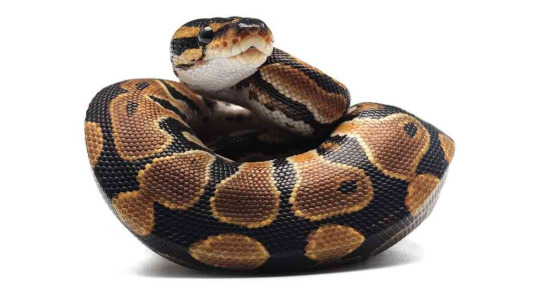
Boa constrictors! Similar in care to ball pythons, BCs get bigger (about 6-10 feet is average depending on species and sex) but are excellent eaters and tend to have great personalities. They can be nippy when they're young, but have probably my favorite personality out of any snake species, they're just very easy-going and amazing to handle. They're a great choice for your first big snake!

Dumeril's boas! Dum's are wonderful. They stay considerably smaller than BCs (average around 6 feet) and have similar care but tend to be a bit snappy and can be picky eaters. If you get them used to handling, you won't have a problem. They're delightful, and their personality tends towards very slow-moving and easy-going like BCs.
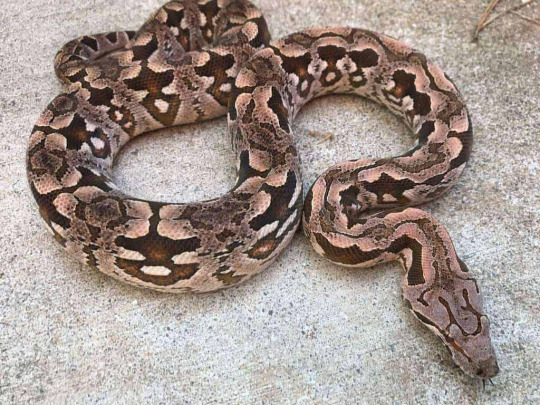
Solomon island and San Isabel island ground boas! These are some of my favorite snakes in the world to keep, I just love them. They're little boas (around 3 feet long) and tend to be super easy to handle as adults. It's my experience that they're very snappy as babies, though, and if you don't have experience with picky eaters, you'll struggle to get them consistently eating f/t rodents. They're super worth the hassle as hatchlings, though!

Carpet pythons! Carpet pythons can be okay beginner snakes, especially if you live in Australia, where they're more common and the strains have been bred more intentionally for handleability. They will need higher humidity (around 60%) and get respiratory infections from improper husbandry very easily, but if you know what you're doing they're not difficult at all. They tend to be very snappy as babies but usually tame down very well.

Arboreal boas! Arboreal boas, like Amazon tree boas, are probably the most advanced intermediate snake on this list, but they're absolutely doable for an intermediate keeper (probably the only arboreal snakes I'd recommend for an intermediate keeper). They're going to need a tall enclosure and very high humidity (80%), and they're nervous and fragile enough that they're not very handleable snakes. They will not tame down well and will be very defensive their entire lives, but they're wonderful if you're looking for a good display snake! They're amazing eaters to boot.

Short-tailed pythons! Short-tailed pythons (blood, Sumatran, and Borneo pythons) have a bit of a bad reputation, but it's mostly down to defensive wild-caught snakes being kept in poor conditions back in the day. Short-tails are wonderful. They're about the same length as a ball python but much chunkier, and they're beautiful and tend to be wonderful eaters. They're not very tolerant of mistakes, so you will want to be on top of things, and they can strike sideways so their body language is difficult to read. They can definitely be a bit snappy, but if you learn to read them, they're a treat and can tame down just brilliantly.
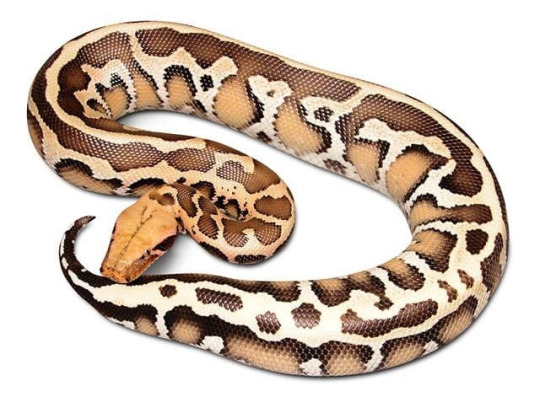
Cribos! Cribos are absolute treats to work with. They're very intelligent and active! They do have amazing feeding responses - like kingsnakes, it's so good you should expect some mistaken feeding bites now and again. Their enclosures can be tricky to set up - you're going to want lots of room and lots of water, they drink a lot of it. They can also be very messy, and I've never met one who didn't love to "finger-paint" with their waste on the enclosure walls, so they're not a great choice if that sounds terrible to you. They're very active and intelligent, so you'll want to provide plenty of enrichment. Very fun snakes to work with!
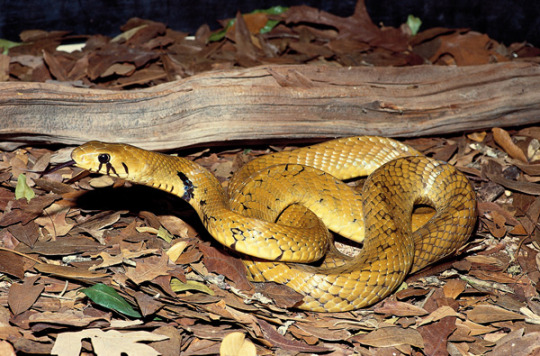
Trickier ratsnakes! Black, yellow, Texas, and Trans Pecos rats fall into this category. Most ratsnakes, excluding some Old World species, are easy in terms of care, but these are a great step up from more docile beginner species. They're going to need tall enclosures with plenty of room to climb, and they're going to be little firecrackers - expect defensive behaviors and tags. Very, very fun snakes to work with, though! Great if you don't want a snake with significantly more difficult care, but you're looking for a more challenging personality.

79 notes
·
View notes
Note
Hello! So I got a new crestie a week ago and at night he's kind of just been in the same spot he was during the day, like he'll move but then he'll stay there for a lot longer than I'd expect [for example say he sticks to the back wall behind his plant at 7pm then I'll wake up the next morning at around 6am and he'll still be there] at first I didn't question it because my first crestie was the same on his first night but I'm a little worried since he was slightly active 4 ish days ago and I'm worried he won't get up to get food [yes I've been feeding him, it's mainly been crickets like every two days because he has a really high prey drive and I'm trying to get him to like/eat the pangea formula since he seems a little uninterested in it right now] and I'd just like him to be active and move. Should I just wait and see? And if its still the same in a few days should I try to handle him at night and hope it wakes him up a bit more, because im pretty sure he is awake because he looks fired up yet he just doesnt move. Thank you!
Hello!
It sounds like you possibly just have a more nervous crestie, but it’s only been a week and sometimes it can take some reptiles a couple of weeks to a month to feel comfortable enough to explore, or he may have a specific sleeping place that he goes back to when you’re asleep. It could be worth getting one of those night vision cameras to see if he’s moving around at night or not 😊
Most of our cresties are fairly active at night but sometimes Biscoff will stay in a hide for a couple of days and won’t even come out for food, and Teacake often wont move if we’re awake too late and she’ll just stay in the same place because she’s a very anxious girl.
A couple of things to maybe consider to see if it’s just an anxious baby or if he need’s something:
Double check that his temperatures and humidity are okay. Some cresties may like it more/less humid or warm than others! If you know the conditions he was kept in before and they’re different now then it could be adjustment of a totally new environment, both in look and feeling. But it may be worth seeing if adjusting temps and humidity for different times of day have any impact.
How much clutter does he have in the enclosure? We’ve found that nervous cresties especially need a lot more cover, but we always make sure they have several branches to climb, plants to hide behind, hides to go into, bridges to use and ledges to jump or sit on. In general we’ve found that arboreal geckos really love and appreciate a ton of clutter that allows them to sneak around with little/no detection and having that option will usually make them more likely to feel comfortable coming out more often and being visible since they have a safety net.
Are you handling him? If so I wouldn’t handle him for a week or two so he can get used to his enclosure better without feeling a possible threat. Sometimes handling a reptile before they’re settled can cause brain or physical problems for them because of the stress, so we always leave it at least a week but usually a bit longer before we handle any animal when they first come home.
How many Pangea flavours have you tried? We always feed a variety, some flavours are less liked than others so sometimes some will skip a meal or two until a favourite is offered. I recommend having at least 3 flavours to alternate between and then only offer bugs once a week (about every 3-4 feeds). This gets him used to a routine and also isn’t giving in to a bugs only diet which would be unhealthy for him. Repashy are also pretty good but also very hit and miss with whether geckos enjoy them, we’ve tried Repashy a few times and none of ours touch it but other geckos love it. For Pangea with a gecko that seems to love bugs I’d recommend the “with insects” flavours since that sometimes entices them more 😊
I hope this helps and gives you some ideas to try! If none of these change anything then you may just have a more anxious animal that will be more active when you aren’t awake.
2 notes
·
View notes
Text
Frill-Necked Lizard Facts
New Post has been published on https://www.petculiars.com/frill-necked-lizard-facts/
Frill-Necked Lizard Facts
Chlamydosaurus Kingii, the frill-necked lizard, frilled dragon, or frilled agama, is part of the Agamidae family and is one of the most common dragon lizards in Australia.
The frill-necked lizard enjoyed fame in Japan for a long time, after which it became the symbol of Australia, along with koalas and kangaroos.
The recognition came from the fact that the image of the lizard was used in an automobile advertisement.
Where is the frill-necked lizard found?
The frill-necked lizard is an arboreal lizard that lives in Australia, Tasmania, and Papua New Guinea. There it lives in dry forests and forest steppe.
A frill-necked lizard spends 90% of its time in trees. When it sits still or rests it is very well camouflaged on the bark. When looking for ants and other insects, it can be very fast and agile.
What does a frill-necked lizard look like?
Its size reaches 85 cm and weighs between 800 and 900g, featuring a sturdy body, elongated limbs, and a long tail.
The distinctive feature is the presence of a wide skin “collar” supported by the cartilage, which expands when the lizard feels threatened. It has a dual role as it is used both as a defense and also in the process of thermo-adjustment.
You might also like my articles on:
Whether Komodo dragons are dangerous
Whether bearded dragons are dangerous
Whether crocodiles are reptiles
The color of the lizard is relatively dull, in shades of gray and brown. Its collar is often strongly colored blue. When attacked, it can run, supporting itself only on the back legs. Because of this behavior, the animal is also known as the bicycle lizard.
When cornered, it turns its face toward the aggressor and opens wide its famous collar around the neck, while opening its bright yellow-pink mouth, as a threat.
What do frill-necked lizards eat?
The frill-necked lizard is an arboreal species that spends most of its time resting at the roots of trees or on their branches. The only time they go to the ground is when they feed.
The frilled dragon is insectivorous and eats, in principle, small invertebrates. However, lizards are sometimes known to feed on small mammals.
These lizards prey on insects, spiders, small mammals, and, sometimes, other lizards. It also likes to eat bird eggs.
Behavioral characteristics of the frill-necked lizard
This creature spends most of its free time climbing up trees or large shrubs, where it can also eat. The frilled dragon is not very active during the hunt, patiently waiting for the desired prey to approach. During the dry season, all the inhabitants have difficulties in procuring their food. But the frill-necked lizard is so patient that it climbs into the crowns of trees and waits there for up to 12 weeks. The fact is that when it is in the shade of branches, the lizard lacks heat, and the metabolic processes in its body slow down by 70%.
In open areas, representatives of the species have a large number of enemies, as these lizards are hunted by wild cats, snakes, and even predatory birds. In the process of evolution, these individuals have developed a unique system of protection.
By its nature, the frill-necked lizard prefers to lead a solitary lifestyle. When the lizard feels danger approaching, it immediately begins to turn into a terrible predatory “beast”.
Although this charming creature prefers to live in low humidity conditions, with the advent of the rainy season, its activity increases several times compared to normal.
At the same time, the breeding season begins, which is very interesting. Before starting the mating process, the male must draw the attention of the female lizard, and as soon as it succeeds, it begins making rhythmic movements of the head that resemble inviting assent. After successful mating, the female buries 8 to 14 eggs in a wet sand hole. After about ten weeks, the baby lizards hatch.
How do they defend themselves?
Seeing the enemy, the frill-necked lizard stops moving, as if numb, and tries to hide so that the enemy does not notice it. If that doesn’t work, then the lizard takes other actions.
The reptile begins making hissing sounds, opening its mouth wide, opening the umbrella collar, twisting its tail, and rising on its hind limbs. In most cases, the predator becomes confused and backs down.
If such actions were not successful, then the lizard quickly runs away, being again upright, using the hind legs, and the long tail to maintain balance.
The frill-necked lizard’s frill
Its peculiarity is that it has a wide collar of skin very well supported by cartilage, which expands when it senses danger. It serves them primarily as a defense mechanism. When opened, the attacker feels like it is in front of a much larger animal than expected.
Another role of its collar is to be a tool for storing solar heat and increasing body temperature. As with other cold-blooded lizards, their body temperature depends on the environment.
In the male this very interesting collar is larger; it can have a radius of 10-25 cm. Its color is yellow, reddish, orange, or brown, depending on the temperature of the environment where the animal stood, how much blood was pumped through its skin, and its stress level.
It also plays an important role in attracting females and fighting rivals.
Cold-blooded creatures
Another purpose of the protruding collar is to regulate body temperature. In the morning, the lizard stays in the sun, and in case of severe overheating, it helps the lizard to cool down.
If this is not enough to scare the enemy, the frill-necked lizard can stand on two legs and run away, but instead of running with its tail between its legs, the dragon will let it hang in the back to confuse its attacker.
Facts about the frill-necked lizard
The frill-necked lizard is one of the most common dragon lizards in Australia.
Its dimensions reach 85 cm and it weighs between 800 and 900 g,
They open their mouth and collar when threatened.
The distinctive feature is the presence of a wide skin “collar” that expands when the lizard feels threatened.
When the babies come out of the nest, they are immediately able to display the front collar, completely.
A frill-necked lizard has a painful bite, produced by the two teeth-like fangs on the lower jaw.
When it runs, it gets up and runs on its hind legs, while using the tail for stabilization. In most cases, it runs to the nearest tree.
The frilled dragon is insectivorous and eats, in principle, small invertebrates.
Chlamydosaurus Kingi does not adapt very well in captivity.
This lizard spends most of its time resting.
The average life expectancy is 12 years.
0 notes
Text
I would like to introduce myself and my Cuban Knight Anole, Jeffrey. Jeffrey is the first reptile that I've owned as an adult and also the first reptile that I've had the financial ability to really set them up with a truly epic tank.
Jeffrey is currently in a small 8-10 gallon arboreal tank. The objects in her (yes, her. Jeff was named prior to sexing) are plastic and it's a pretty "sterile" environment. Because it is a "sterile" terrarium I do need to take everything out and clean the tank and all her decorations. I got her set up in the "sterile" tank for just the first year cause she was a baby and I knew that she would outgrow the tank that she is currently in within a couple of years.
Last weekend, I purchased her adult tank:

This is where the adventure begins. I will be chronicling the adventures in setting up my first ever bioactive terrarium. I am currently researching which plants would be best, lights to grow them, and what type of soil and cleanup crew is going to be best.
We have the lizard, and we have the tank. Next is the misting system.
In the next 2-3 weeks I’m going to be getting the MistKing system then comes the lighting then the actual parts of biome (dirt, plants, etc.)
I apologize that this page will be slow going for now but I’m excited to share this journey of taking this sterile glass box and turning it into a beautiful piece of nature for my darling Jeff.
#reptile#bioactive#vivarium#experimentation#newbie#anole lizard#anole#Cubans knight anole#Jeff the Lady Lizard
1 note
·
View note
Link
Chameleon are arboreal - this one gives birth on a stick, off the ground, crazy!
Ovoviviparous birth - developed in Chameleons as an answer to cooler climates. The mom can keep the eggs at a preferable temp. In this case, the eggs develop inside the mother, hatch from the egg inside her body, and exit the mom like a viviparous or live birth.
Another chameleon a more temperate species, I’m guessing, is oviparous - mom laying eggs, eggs hatching without mom present. https://www.youtube.com/watch?v=D152__yJDR4
Other posts you might like:
Rosette Nosed Chameleon
Parson’s Giant Chameleon
Leaf Nosed Chameleon
#chameleon#ovoviviparous#birth#reptiles#ovoparous#babies#animals#arboreal#africa#madagascar#cute#live birth#trippy
3 notes
·
View notes
Text
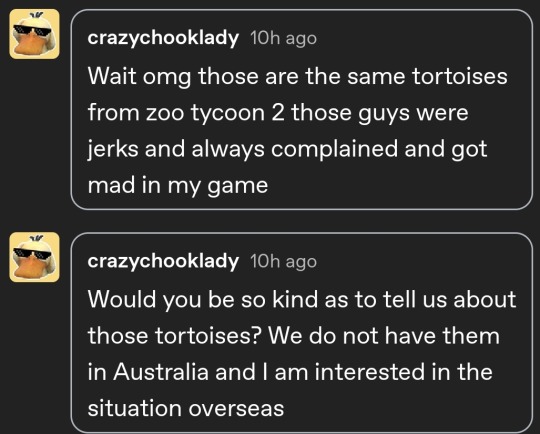
@crazychooklady they ARE the tortoises from Zoo Tycoon 2! Also known as African Spurred tortoises.
So, these guys aren't as mean as iguanas are, but they have a similar underlying issue:
1. They are very cute and small as babies, but eventually grow to be the THIRD LARGEST TORTOISE SPECIES ON EARTH.

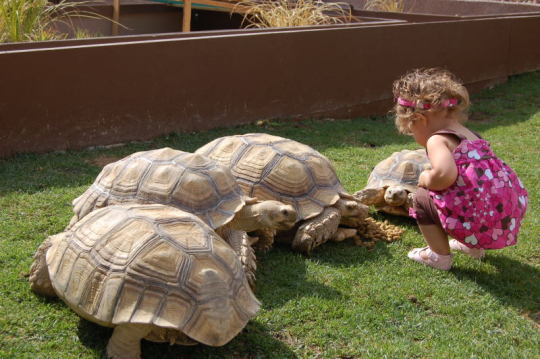
2. Because of this (and the fact that they live to be 70+), their care is *pretty extensive.* If you live in the south and have a big yard (with shade and water and REINFORCED FENCE that goes into the ground)- they can be kept outside. But they need heat, they can burrow like a bulldozer or a Badger mole, and they eat a *lot* of salad.
They, like all reptiles, have specific diet needs. Their shells will deform if they get too much protein, their bones will turn to mush if they don't get enough calcium, and they get respiratory infections if the humidity is too high.
Despite being *slow* tortoises like to move- they motor around all day long and try to dig their way through or climb over anything in their way. They are NOT inactive little rocks- they need space.

Literally just how they are.
3. They lay a LOT of eggs. We are talking 20+ eggs per clutch, with potentially multiple clutches a year. This means that, in the right circles (wrong circles)- sulcata babies are sold very cheap and with very few questions. Because maybe you can comfortably house 2 sulcatas. But you can't house 22 or 42 or 62 sulcatas. And how many people in your area do you think will pay a lot for a tortoise AND have the means to care for one? Not 62 I'll bet. So you got to sell off those little suckers fast to anyone who will take them before they get too big for your house. I've seen them run around $40 at expos.
They have started to become invasive- not as widespread or dramatic as iguanas, but more and more they are turning up in places they shouldn't be and threaten local tortoises through competition.
They aren't as aggressive as iguanas and they aren't arboreal, so points there. But an adult will weigh 100+ pounds and has the ability to cause serious property damage if it wants to go somewhere and a poorly constructed fence, door, or wall is in their way.


All of this means that reptile sanctuaries are *swamped* with them. They get dumped all the time, and people who generally get a new one will find a cheap baby at a reptile store or expo long before they look into local rescues.
I'm a firm believer that reptiles are incredible pets. But they also require research and care that goes beyond a cat or dog. And they *deserve* good care. So super irresponsible pet trade nonsense like this just makes me furious.
129 notes
·
View notes
Note
Hi, it's me again. Can I request h/c's for Spinner with an s/o who gives him a baby iguana as an anniversary gift or something and bursts in the house like "SHUICHI YOURE GONNA BE A FATHER-"
Thank you in advance and for your time
So I didn't go with a baby iguana just because i have more experience with Crested Geckos. I own one, and they're arboreal (so they can climb) like Spinner can. Yes, Iguanas can too, but its just that I've got more experience with Crested Geckos. I'll put a picture of my geckos at the bottom ^-^

Best pet for spinner is hands down an arboreal species of lizard, doesn't matter which one
I feel like its always something that was in the back of his head but I don't think he'd ever get one himself
So when you show up with this tiny little gecko with things that look like eyelashes, its a little surprising to him
He'd be like a little kid getting their first reptile, just watching it move around the tank until it goes into hiding
You always joke about it being his son and honestly, with how much pride he takes in it, it might as well be
The first time he holds it will probably be a month after you got it, bc yknow, baby has to get used to its new home first
Its so soft compared to his rough scales, and he treats it like an egg
^ by that i mean he will literally cradle it
The first time it wraps its tail around his finger, he's in love
He spends hours researching the species the first time he sees it. Everything from what it eats to what kind of morph it is (like the design)
With crested geckos specifically, I think he'd like the "crest" or what I described as the eyelashes (even though it runs down their backs too). It just makes them stand out a little more
He sits on the floor with it because baby Cresties jump quite a bit
He tries to get it to chirp without bothering too much, but it never works
He offers to pay for the tanks and whatever you put in the new one once it gets bigger
Whenever he's on a mission, he checks in on you and the lizard and reminds you to feed it (if he didn't before he left) or spray it's tank
He LOVES taking it out of its tank and just watching it walk on his arm, scaling him like it would a tree
His wallpaper on his phone and computer is you holding the gecko
^ gotta have his two favorite beings everywhere
He probably shows it around the hideout like it'll be anywhere except your shared room and its tank very often
^ probably not because Shigaraki and Dabi, I feel like Toga would be gentle with it once she realizes its his son pet
Yknow how some people have those stickers like "proud mother of a german shepherd"? He has a whole pile of those and he puts them everywhere
His whole photo gallery is just you with the gecko and you can't change my mind
^ yes its excessive but hey, a simp's gonna simp
He'll let you name it but he has a photo album titled "Spinner Jr." but he still calls it whatever you named it
^ he let you name it only because you bought it for him
He talks to it just as much as he talks to you so it can get used to his voice (yes, that's a thing)
Literally wants to cry when it stays still in his hands because he thinks it trusts him

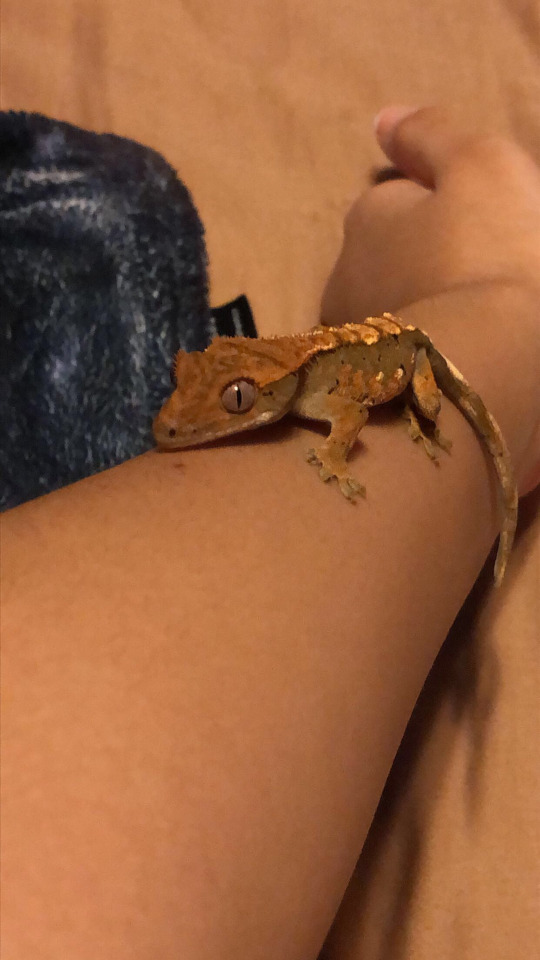

So the brown one is my crested gecko, I named him Caspian. His crest isn't as visible as it usually is in that picture, but you can always find better pictures of it online. The other one is Henry, and she (yes I said she bc my brother named her before we found out she's a girl) and she's, if I had to guess, 5 or 6 years old. I got Caspian somewhere in March I'm pretty sure
#spinner#spinner x reader#shuichi x reader#shuichi iguchi#bnha spinner#shuichi x y/n#iguchi shuichi#bnha fluff#bnha headcanons
94 notes
·
View notes
Photo


#aniya#gargoyle gecko#gecko#lizard#lizards#reptiles#reptiblr#herpetology#herpblr#arboreal gecko#arboreal#baby gecko#mine
2 notes
·
View notes
Text
Hello there fellow recluses. It's kind of really late in the subject but I never made my announcement on updates in a couple months. In September, I went to a reptile expo and acquired the tiniest most colorful tarantula. I've wanted one for a long time and I got one. This baby Typhoclaena seladonia has been in my care for a full 2 months now. Her and her other siblings were only hatched in July. So currently she's only 4 months old. Still she's beautiful.



Absolutely stunning in colors. There's a reason why this arboreal trapdoor tarantula is called the Brazilian jewel. And with her she became my 14th tarantula. It's not so much news anymore to me but I haven't gotten around to showing her on my page. So here you go. My beautiful addition to my tiny family.
8 notes
·
View notes
Text
AAA THERE'S A REPTILE EXPO ON THE 17TH!
If I play my cards right I can probably go. Bills and the like come first obviously XD
There's two species of tarantula i'd love to find if I can.

The Green Bottle Blue tarantula (Chromatopelma cyaneopubescens)
anddddd

Antilles Pinktoe Tarantula (Avicularia Versicolor) Note, that the babies are bright blue!!!
They are absolutely STUNNING. I will need to get them as slings, and as luck has it I have two arboreal sling enclosures :3 GBB are semi-arboreal so their enclosure would need to be a little different.
Other than that, I'll be looking for more millipedes to give Ripley and Buu some more friends, as Millies are communal. That and buying more substrate and cork bark and looking for more isopods. I have room for two more isopod colonies and that's it XD
#bug stuff#tarantula#spider#arachnophobia#wishlist#hell even if i can't buy anything I love to go to the expo and look at everything#im really excited#i hope i can save enough to go!
9 notes
·
View notes
Note
What kind of reptile/amphibian could comfortably live in a 24-18-18 terrarium? It’s a terrarium from when my cornsnake was a teeny baby and now it’s just standing around empty.
In that size you’re pretty much limited to small, terrestrial frogs and geckos.
As a side note, make sure that you choose a species that not only will be happy in a 24x18x18, but that you are passionate about! I see a lot of people wanting to fill empty tanks just so they’re not empty, which can lead to being overwhelmed with pets. Not saying that’s what you’re doing, but it can happen by accident so always good to have the reminder.
Now, with that out of the way, here are some options to consider. This is not an exhaustive list, there’s certainly a few other species that would work, but off the top of my head here are some options:
-male pacman frog (genus Ceratophrys)
-one tomato frog (Dyscophus guineti)
-one or two chubby frogs (Kaloula pulchra) (debatable- they are known to have arboreal tendencies despite being primarily terrestrial and would likely benefit from more height and climbing opportunities)
-certain dart frogs (more arboreal species would prefer a 24” height or more, but some darts are primarily terrestrial and would be okay)
-1-3 fire belly toads (genus Bombina) (semi aquatic- if your viv is front opening they may not be the best choice since it’ll be hard to provide a variety of water depths)
-pair or single ocellated gecko (Sphaerodactylus argus)
-pictus/panther/ocelot gecko (Paroedura pictus)
13 notes
·
View notes
Note
hi!! i've been researching gargoyle geckos and am thinking of getting one in a few months :) do you have any tips or opinions on keeping one?
i have 2 corn snakes so i have some reptile experience, but this would be my first gecko!
thank u!! :]
Hellooo!
Omg so gargoyles are amazing little guys and definitely underrated imo!
They're quite easy to keep really, Lichen is quite chilled out in his enclosure and usually he's just vibing. Most of the more advanced, science-based keeping guides for crested geckos will basically work for a gargoyle too! The care is pretty much identical - the only difference we've noticed is that Lichen has always loved bugs but cresties are hit and miss with them.
Gargoyles are less jumpy typically but will run and can be very skittish, but you learn their behaviours and body language and that helps. Plus if they get startled enough to drop their tail at least it will grow back!
General key requirements
45x45x60cm enclosure minimum for an adult (exoterra and habistat are our faves). Arboreal enclosures or any enclosure with a lot of height is good!
UVB is required, to have a healthy gecko. Lichen uses his UVB daily and has done since he came to us (about 6-8 months old). Give lots of cover so that they can cryptic bask if they don't want to full body bask.
Heat gradients are helpful but make sure temps don't go above 27°C as much as possible, maybe 28 at a push. Gargoyles, like cresties, are sensitive to heat and too high can be fatal. 21-24°C at the bottom is usually good.
Humidity should be 60-80% but it's okay to sometimes let it drop to as low as 40% as long as it isn't for long periods. A natural fluctuation of humidity helps them shed better!
Bioactive is super good with all new caledonian geckos if you feel confident with it, lots of good tropical plants that are reptile safe and they thrive in the humidity needed. Of course not necessary but make sure to clean out the enclosure every 1-2 months if you don't have a cleanup crew and live plants. Reptile carpet should be avoided at all costs (for all reptiles, not just gargoyles)
Good option for food is Pangea if it's available, it's got amazing balanced nutrition! Repashy is probably the next best that I know of. You should have 3-4 flavours to alternate between. Every 3rd or 4th feeding you should offer live insects to offer them better nutrition. Some don't like bugs and in that case make sure that at least half of the foods have insects in them.
Lots of clutter! Make sure to have a mix of branches, plants (live and/or fake) and hides for them to hide in and climb. Having some horizontal spaces is necessary otherwise it can result in floppy tail which can be damaging to your scale baby (applies to all arboreal lizards).
I hope this has been helpful to you and maybe others too! 🥰
Here is a fired down Lichen to thank you for reading this info dump

[ID: Lichen the cream and grey gargoyle gecko standing on some plant leaves and leaning on a rainbow crochet paracord bridge in his enclosure]
14 notes
·
View notes